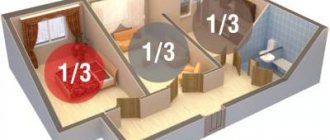Valuation of a share in an apartment is a rather complicated process, even for a professional. Not everyone, even a very experienced expert in this field, can correctly determine the cost of a share of residential premises, not to mention specialists in related fields for the sale of apartments and non-residential premises.
The cost of an apartment, for example, can be determined by any real estate amateur using a simple comparison method. It is better to use for this, of course, any Internet database of apartments, of which there are currently a great many. Experienced realtors who started working even before the Internet era often recall how they used only newspapers and real estate magazines for comparative assessments (there were simply no other reference points then). To get a clear understanding of the price, it is enough to compare the parameters of the appraised apartment with several others, with similar parameters, currently on sale or sold recently. The error margin for the relative cost of the apartment will be negligible. The difference will be in the quality of the repair or some other details, but in general, the price will be determined almost correctly. This method worked in the mid-90s, and it still works reliably today.
For such a scrupulous matter as assessing a share in an apartment , this old grandfather’s method is not suitable. Small, at first glance, details have too significant an impact on the price of a share. But it is from them that the overall picture of any, even the most incredible share in the apartment emerges.
Note! The vast majority of Shareholders, before they assessed the share in the apartment , naively believed that the cost of the share of the apartment was easily calculated by a simple arithmetic ratio of the size of their share in the apartment to the total cost of the entire apartment. They believed that to understand the price of a share, they needed nothing more than to find out how much the entire residential premises cost and isolate their share size from this cost. Alas, this is not true.
Now the share market is oversaturated with initially unsaleable options offered at inflated prices. This happened due to the fact that everyone who is not too lazy began to do appraising a share in an apartment The operating principle of a real estate agency is simple - to lure clients to you with high prices. Therefore, when answering calls from clients, efficient agents do not hesitate to announce to them higher prices for their shares of apartments than they actually are, and, at the same time, in every possible way convince the client that they will be able to sell them at this price.
By inflating the price of shares, the real estate agency deliberately goes against the laws of the market, however, at first the deceived owner even likes that his property is valued at a high price. Deep down, everyone hopes that a buyer will be found. But, at the same time, the logic of realtors is correct and lies in the fact that six months later, when the client’s patience and the contract are already running out, they convince the seller to significantly reduce the price, citing this circumstance as a change in market conditions. As a result, the Shareholder remains with the agency again, and the share is sold at a lower price. This is the so-called process of “compacting” the client. A similar procedure occurs after another six months, and only then the share of the apartment reaches a more or less market price.
For the swindlers, there is a direct benefit in this continuous flow - some, having lost hope, reduce the price, and their shares, at the very least, are sold, others, full of optimism, are just entering this process. Overall, not bad, right?
Sometimes, a more compliant client can be brought down from heaven much faster. Such unfortunate sales drag on for years, but the agency has at least fifty shares on sale at once, and this is already, well, very respectable! Market professionals have a good rule - call last year's options, the most interesting thing is that they have not gone away, but have only become cheaper.
Interesting! “Well, how is the client, is he okay? “Aren’t you ready to pay for so much?” they ask ironically. “Noooo! Not yet ripe. Well, soon!” - They answer with understanding at the other end of the tube.
This story usually ends with the client, in despair, starting to independently look for a buyer for his product at a lower price. Having swallowed his fill of generous promises, having lost many months, the client begins to independently call companies found on the Internet that actually buy out shares of apartments. However, they, in turn, cannot do anything, because it is easier for them to wait until the contract with the agency that hooked the client ends. It’s easier to wait a couple of months than to restore the documents again. Then, the client, with a scandal, snatches his documents from the agency (not a single agency will return your documents before the end of the contract), and makes a deal at a price completely different from the one he was scammed at in the beginning. To a lesser extent, of course.
This is a completely common practice, which 99 out of 100% of Shareholders who want to get rid of their property buy into. In order not to fall into the ranks of these losers, we will tell you how you can independently evaluate the share of an apartment. Thus, having carefully studied and analyzed the information presented below about the main criteria by which the correct assessment of the share in an apartment , you will be able, more or less, to talk on an equal footing with realtors who will fool you.
Remember the most important thing! Before you go anywhere, first try to evaluate your share in the apartment yourself. If in doubt or if it doesn’t work out, contact our specialists or site users through the comment form or forum. They will definitely answer you, and quite quickly. At the same time, you will lose a day or two on correspondence, but you will remain “free”, having at least some objective idea of the property you have. This will greatly simplify your further communication with potential buyers; by the way, there are plenty of them on our website. They may well be interested in your option during the discussion, if, of course, it is worth anything. You will always have time to stick your neck into the yoke of a real estate agency for many months.
Why do you need to know the price of a shared element of a home?
More often, the procedure for identifying the price range of private space in a house is required when resolving property disputes:
- Division of property between spouses;
- Entry into inheritance;
- Redemption of a share by another owner;
- Collection of real estate to pay alimony.
The procedure is ordered by the court or carried out independently at the initiative of the interested party.
The event will also be needed in the following cases:
- The need to recalculate mandatory tax payments;
- Registration of a share as collateral for a loan;
- Purchase and sale, rental or exchange;
- Participation in tenders, auctions (when collecting debt, carried out by FSSP employees);
- Registration of an insurance policy
Sometimes the part of the house that is owned is included in the authorized capital of the enterprise.
When exchanging shared elements of a home, the share belonging to a minor is taken into account: a reduction is not permissible. This process is regulated by social protection employees.
Features of valuing a share in an apartment
To correctly assess the value of a share, an expert must take into account many factors:
- existence of a procedure for the use of common living space, fixed by a written agreement or a court decision;
- availability of free access to the apartment;
- the amount of living space allocated to the shareholder;
- presence of a separate entrance to the room;
- number of remaining shareholders;
- number of residents;
- presence of minor owners, etc.
It is necessary to take into account that the market price of a share is not proportional to the cost of the entire apartment. So, for example, if a person owns half of the property, and the cost of housing is 4 million rubles, you cannot count on 2 million rubles: the amount will be lower. The fact is that the buyer of the share will actually receive communal, rather than individual, living space, with all the ensuing inconveniences and risks. Therefore, a reduction factor must be applied - from 0.5 to 0.7. If we return to the above example, a share can be sold for 1-1.4 million rubles.
A different situation arises when one owner buys out a share from another. In this case, it is advisable to proceed from a fair price. This means that the share must be calculated in proportion to its size. Returning to the example, the fair value of the share will be 2 million rubles. However, such an approach is only possible with mutual consent of the owners. Otherwise, the market price of the share is determined.
Who has the right to evaluate the share in the apartment?
This procedure can only be carried out by professional appraisers. We are talking about individuals who have the appropriate education and experience, have insured their liability and joined an SRO. If assessment services are provided by an organization, it must have at least 2 such experts on its staff.
Method No. 1: how to determine the value of a share when selling an entire apartment
Calculating the price of their share turns out to be simple if the owners decide to sell the apartment immediately together, as a whole, in favor of 1 buyer, and then divide the proceeds between each other in proportion to their shares.
Initially, the owners will need to find out the market value of the alienated property. This amount is calculated either by an experienced appraiser or by the owners themselves - through a simple comparison. This method consists of monitoring the Internet database of apartments and searching for objects that are similar in description and parameters to the parameters of the property being sold. It is important that the advertisements are relevant. The properties being compared must either be currently being sold or have been sold recently.
If the buyer agrees to the use of such a method and does not object to the price received, then the parties have the right not to use the services of an independent appraiser.
When calculating the cost of an entire apartment that all shareholders decide to sell at once, it is necessary to take into account the following indicators:
- Square.
- Number of storeys.
- Number of rooms.
- Availability of repairs.
- Location.
- Type of house and year of its construction.
- Surrounding infrastructure.
After the sale and purchase transaction, each shareholder will receive the amount of money calculated using the formula “market price of the entire apartment ÷ number of all shares * size of his share.”
Example. 4 owners each have a 1/4 share in a 2-room Moscow apartment located in a residential area. The living quarters belong to the standard category (economy class). The co-owners decide to sell the property to 1 buyer. On the real estate market, the cost of similar apartments varies in the price range from 6 to 8 million rubles (depending on the area).
Through careful analysis of the data, the owners determine that the real value of the apartment they own is 6 million rubles . This means that after the sale and purchase transaction is completed, each of the former owners will receive 1.5 million rubles (6 million ÷ 4 shares * 1 share). This value is called the ideal price of an apartment share.
Method No. 2: calculating the price of a share alienated to a close person
When selling a share of an apartment, it is also important in whose favor the alienation takes place for compensation. If the buyer is a third party, then everything turns out to be obvious - the cost is calculated based on real indicators and parameters of the property. However, if the acquirer is a person familiar and close to the seller, then the so-called "subjective factor".
The owner has the right to agree with the acquirer on certain concessions and discounts on the alienated share. In this case, the price will be individual and not subject to rational explanation by an experienced appraiser (after all, in fact, the owner simply takes and sets this or that value). This right can be either used by the seller or ignored.
Example. After the divorce, citizen N., who owns ½ share in the common ownership of residential premises, wanted to sell his part of the property in favor of his ex-wife. The woman remained to live in the apartment with the minor children she had born to N. The former spouses agreed that the price for the alienated share would be less than if N. had sold his property in favor of 3 persons.
The woman acquired the alienated share under her preemptive right of redemption, because she was listed as the owner of the other ½ share.
Method No. 3: calculating the price of a share alienated to a 3rd party
The most difficult and unprofitable case for the owner is the case when he has to sell his share to a third party. The point is that 1 sq. m of a separate share will always cost less than 1 sq. m. m. of an entire apartment (including one that is sold immediately by all owners together). Both the residential premises themselves and the shares in the common ownership rights to them may be completely similar, however, per sq. m. m. share the buyer will pay less - on average by 30-50%.
The presence of such a significant discount is explained by the fact that when purchasing a share, the acquirer also assumes certain inconveniences and risks associated with owning and/or using communal housing. In addition, since the seller was unable to sell the property using method 1 (agree with co-owners to sell the entire apartment at once) or method 2 (sell the share to a co-owner under the pre-emptive right or to a relative), then this will be a “bell” for the buyer - residential premises belongs to the problematic category.
Here, a simple arithmetic calculation can no longer be used, where the market value of the entire housing is first divided by the number of all shares, and then multiplied in proportion to the share of the owner (seller). Even though you need to find out the average market value of an apartment, the factors influencing pricing will turn out to be different. They will be related to how profitable it is for the buyer to purchase this particular share in comparison with other shares in the market.
Comments (14)
Alexandra|
2016/07/05 Hello, please tell me my mother wants to sell a 1/5 share in a 3 km apartment of 62 m. where should I go? and how to evaluate an apartment? Thank you. admin| 2016/07/18 Hello Alexandra! First, you need to notify the other owners of shares in the apartment of your intention to sell it, since they have a pre-emptive right to purchase. To assess the value of your share, you can contact any expert appraisal company that provides real estate appraisal services.
Olga| 2016/12/28 Hello. My brother offers me to buy out a 1/4 share in a two-room apartment, but the amount does not correspond to reality. What should I do if he does not agree to the appraisal examination?
admin| 2017/01/10 Hello Olga! Unfortunately, the brother, as the owner of the property, can sell the property belonging to him at a price set by him alone. However, if you have a pre-emptive right to purchase a given share, and it later turns out that the share was sold to third parties for less than what was offered to you, you will be able to challenge such a transaction in court.
Ekaterina| 2017/02/01 Please tell me. We have a two-room apartment. My mother and I are owners in equal shares. Two minor children are registered in the apartment. Mom wants to change her apartment. I'm against. She offers to buy out her share of half the apartment. How much is her share actually worth?
admin| 2017/02/08 Hello Ekaterina! The reliable value of a share in a residential property can be determined by contacting an expert appraisal company specializing in assessing the value of residential premises. Based on the results of the inspection and research, experts will determine the real and actual value of the share in the apartment at the moment.
Natalya| 2017/03/10 Tell me. The apartment is privatized for my sister and me. 50/50. I live in another city. Her 1.5 year old son is registered there. She is pregnant with her second and will prescribe it accordingly. He asks me to register my husband. Will I be able to sell my share and will the number of registered ones affect the price?
admin| 2017/03/22 Hello Natalia! You have the right to sell your share to both your sister and third parties, however, a large number of persons registered in the apartment can often scare off a potential buyer, even though such transactions do not contradict the law.
Elena| 2017/06/22 Hello. I was offered a preemptive right to buy a room in an apartment, but the market price was 2.5 times too high. I made an assessment. There is a suspicion that the seller may conduct a fictitious transaction in order to obtain maternity capital. The possible buyer is the daughter of his common-law wife. In response to the offer to purchase, I replied that I was ready to buy at the market price and referred to the appraisal. My next steps? What else can be done to prevent a transaction that infringes on my rights?
admin| 2017/07/04 Hello Elena! Unfortunately, the seller of a share, in accordance with the law, has the right to independently set and determine the price. However, if this share in the apartment is sold to third parties on other terms, you will be able to challenge this transaction in court.
Alexandra| 2018/02/13 Hello. How can I find out that the share in the apartment has been sold to third parties under different conditions?
admin| 2018/02/19 Hello Alexandra! Information about the owners of residential premises is contained in the unified register of rights to real estate and transactions with it. To obtain information about the owner, you can contact the MFC to obtain the corresponding extract from the Unified State Register. If you believe that the share in the apartment was sold under different conditions, you can go to court and through the court (at a judicial request) request documents about the cost and conditions under which the share was sold. Unfortunately, you will not be able to obtain this information from the relevant authorities on your own.
Natalya| 2019/09/21 Hello, please tell me when the 1/5 share in a 2-room apartment is valued. apartment where there are 2 minor children, what legislative acts should the appraiser be guided by in order to appraise? Shouldn’t it be lower than the cost of the whole apartment? Thank you.
admin| 2019/10/11 Hello Natalia! When determining the value of real estate, appraisers are guided by the provisions of the Federal Law “On Valuation Activities in the Russian Federation” and various methodological recommendations. In particular, the cost of similar real estate in the region of residence is taken into account. To determine the most accurate market value of real estate, you can apply for the appropriate service to the Rosreestr Office at your place of residence.
What are the challenges of assessment?
The difficulty in estimating the share of an apartment is that pricing is influenced by so many factors. The biggest mistake that many sellers make is that they set a price for their living space as if it were just part of an apartment.
If the property costs 4 million, and the co-owner owns ¼, then it is most logical to sell your part for 1 million. But in reality, the price for a share in the property will be significantly lower.
It would be most profitable to come to an agreement with the other co-owners and sell the entire apartment at market value. But this is not always possible, because shared ownership is often associated with conflicts and disputes about the use of living space.
There are a lot of pricing factors, and the sale of a share itself has some legal restrictions.
Conclusions and recommendations
Thus, taking into account the position of the highest courts of the Russian Federation and the established business practice, it can be strongly recommended that when a participant leaves the founders, the actual value of his share is assessed based on the calculation of the market value of the assets reflected on the balance sheet of the LLC with the involvement of an independent appraiser. The appraiser's report ensures that the actual value of the participant's share upon leaving the LLC is determined in accordance with the Law, will help save time and avoid litigation later.
Factors affecting cost
The difficulties faced by the owners of one fragmented property are associated with the inferiority of the content of the laws of the Russian Federation. The share is not legally fixed by the number of square meters. This is part of one whole, divided into several owners, ½, 1/5 or even 1/12, but which room or part of it belongs to a certain person is not clear. In this case, it is advisable to determine the order of ownership in court or independently.
It is more convenient when the court makes a division in kind, that is, each owner is assigned a room. The price range of such an element of the house in the second option is 1.5-2 times higher than the first.
Also, in addition to the characteristics of the housing, the assessment of the share in the house is influenced by:
- Availability of an agreement (court ruling) on the procedure for using housing (must be notarized without the participation of the court);
- Share area;
- Identity shares a separate room;
- The number of shareholders, especially the number of minor shareholders (if you want to sell a house, you need the consent of an adult, which means you have to wait)
- number of residents.
An elite area, expensive renovations and other nuances that would increase the cost of the whole house, in the case of a part, practically do not matter. A buyer would rather buy a separate home without renovation than a piece of real estate with it.
Free access to the apartment is a conditional factor that has a positive effect on the increase in value. If the remaining co-owners have a negative attitude towards the new owner, the price falls.
Factors that positively influence the price
Even with a downward discount, some shares are still valued higher than others. This is due to the presence of the following pricing factors:
| Free access to residential premises (up to +30% of the originally calculated price). | This means that the purchaser can immediately begin to use his part of the living space - without problems or obstacles, for example, from aggressive co-owners. If a potential buyer risks having problems moving into the apartment, this will result in a drop in the value of the property for sale. |
| Correspondence between the number of rooms and the number of owners/total number of shares (up to +50% to the price). | This factor is valued by buyers because if there is such a correspondence, they acquire not only a share in the right of common ownership, but also a real isolated room. Usually, it is precisely this “room-by-room” use of an apartment that is established by the owners themselves (voluntarily) or the court (compulsorily), if there is an objective opportunity to equally divide the housing. For example, the ideal option for sale is:
|
| Large footage of the apartment (up to +30% to the price). | Sufficient area is an opportunity to carry out various real estate transactions in the future. In other words, even if the buyer purchases a share in an 80 sq. m. apartment. m. for occupancy, in the future he will be able to offer other owners to “exchange” it for 2 apartments of 40 sq. m. m. This cannot be done with a small living space (for example, a modest one-room apartment). |
| Only 1 sharecropper (up to +20% to the price). | Living in an apartment with 1 co-sharer turns out to be a potentially more attractive option than living in an apartment with 2 or more co-sharers. The rule here is: “the fewer owners or registered persons, the higher the price.” |
| The shareholder has other real estate, although he lives in the apartment where the share is being sold. | For some buyers, this factor becomes a pleasant bonus, because it means that in the future another shareholder may simply move out. In addition, purchasers perceive co-owners who own other real estate as conflict-free people - after all, if something happens, they will always have a spare roof over their heads. |
| The apartment in which the share is being sold is completely free (up to +100% to the price). | This option attracts a large number of potential buyers, even though the absence of residents in the apartment may be a temporary phenomenon. So, it can last until the other co-owner reaches the age of majority, returns from a long trip abroad, etc. And yet, competition often arises for the acquisition of a share in such an apartment. |
Factors affecting the price negatively
On the contrary, it is by definition impossible to evaluate other shares highly. Circumstances are developing around them that are not favorable for the future sales process. We are talking about:
| Presence of minor residents/minor owners (up to -50% of the initially calculated price). | Minors, especially minor residents and/or owners, are a potential need for the buyer to contact the Guardianship and Trusteeship Authorities. If in the future a person decides to make any property transaction with entire real estate, then it will not be enough for him to obtain consent from the child’s legal representative. The PLO will also oblige the co-owners to purchase an equal share for the minor. This can negate all material benefits from the transaction. |
| The presence of co-tenants waiting to receive an apartment from the state (up to -30% of the price). | Despite the fact that sometimes they try to present this factor as an advantage and the prospect of a speedy departure, in reality this turns out to be completely different. In most cases, owners who wait to get an apartment are “stuck” in line for decades. |
| The high cost of the original housing or the share itself. | Shares in expensive apartments are sold very rarely. The reason lies in the fact that there is no demand for such offers among the mass buyer. For example, you can imagine an apartment for 100 million rubles with 2 owners. On the one hand, the seller will not want to sell his ½ share for a purely symbolic fee. On the other hand, no one will buy a share for 50 million rubles, because if the buyer has that kind of money, he will invest it in a more profitable offer. In most cases, transactions for the sale of individual shares are made with apartments of low or medium price categories. The cost of shares does not go beyond 5-6 million rubles. |
| Availability of a large number of residents/registered persons (up to -30% of the price). | A densely populated apartment is an unattractive option, because sharing such housing can turn into a big problem. The situation gets even worse if there are children or elderly people among the residents. Serious difficulties with selling a share arise if more than 3-4 people are registered/living in the apartment. |
| Inability to inspect the residential premises (up to -30% of the price). | If the acquirer does not have the opportunity to inspect the object of the transaction in advance, this may discourage him from making an offer. |
| Unequal ratio of shares. | When shareholders have equal or approximately equal shares in the right of common ownership (for example, 1/3 share for 3 people, ½ share for 2 people, etc.), they subconsciously treat each other with more respect. This ratio of shares assures the owners of the opinion that their rights are completely equal (despite the fact that their rights are completely the same even with a completely unequal ratio of shares). Some buyers do not want to purchase a small part of the property if the remaining majority (for example, “a full 5/6 share!”) is owned by another owner. Others themselves do not want to take possession of almost the entire apartment, believing that along with a large share they also receive greater responsibility. |
Example. So, in order to independently calculate the value of a share alienated in favor of a 3rd party, you will need to use the following formula “(market value of all housing ÷ number of all shares * size of your share) ÷ 30-50% downward discount + all pricing factors.” If the market value of housing is 6 million rubles, and the owner decided to sell his ¼ share, then taking into account the downward discount (discount), the price of his share will be from 750,000 rubles. However, this value will not be final - you will also need to add or subtract all the pricing factors indicated above.
"Pitfalls" when determining net assets based on financial statements
Arbitration practice shows that most lawsuits are related to an understatement of the actual share of the withdrawing participant. Moreover, if the owner left the Company by agreement of the parties, there is practically no chance of recognizing the “book” value of the share as erroneous and bringing it to the market value (for example, Resolution of the Seventeenth Arbitration Court of Appeal dated May 26, 2016 No. 17AP-5136/2016, Resolution of the Arbitration Court of the Ural district dated 09/02/2016 No. F09-7428/16 in case No. A50-11301/2015, Ruling of the Supreme Court of the Russian Federation dated 01/27/2017 No. 309-ES16-16050).
An even more reliable way, which can even lead to a complete refusal to pay the share, is to create signs of bankruptcy in the accounting and reporting data or, at least, to create a “negative” net asset value due to losses.
Conversely, in the interests of the owner leaving the Company, the value of net assets may be overestimated.
Under pressure from the interests of managers or participants leaving the Company, the accountant is forced to “play” with the assessment of net assets through related assets and liabilities (Table 1).
Table 1 - Methods of manipulating the value of net assets in the interests of participants
| In the interests of a participant leaving the Company | In the interests of the participants who remain the owners of the Company | ||
| Methods that directly violate the requirements of regulatory legal acts | – revaluation of fixed assets and other non-current assets, provided that the accounting policy does not provide for revaluation; – avoidance of creating estimated liabilities (for example, a reserve for vacation pay); – failure to reflect shortages and losses of inventories; – writing off actually incurred expenses of the reporting period to account 97 (“postponement of expenses”); – suspension of depreciation on fixed assets (under the guise of imaginary conservation); – failure to reflect retro discounts in the reporting period (carrying forward losses); – early recognition of revenue and other income, etc. | Methods of direct violation of the requirements of regulatory legal acts | – write-down of fixed assets and other non-current assets, provided that the accounting policy does not provide for revaluation; – unjustified transfer of contingent liabilities into estimated ones; – recognition of damage, breakage, scrap of inventories without real inventory procedures; – 100% recognition of retro discounts and bonuses in reporting; – unreasonable use of accelerated depreciation; – reflection of investment expenses as part of current expenses; – recognition of advance expenses on a “cash” basis before the period of their consumption (for example, expenses to pay rent for the coming year); – transfer of recognition of revenue and other income to future periods, etc. |
| Ways to manipulate the uncertainties of current accounting and reporting standards | – failure to form valuation reserves (for doubtful debts, for depreciation of financial investments, for reduction in the value of material assets) or their assessment in a dubious manner; – changes in accounting policies (for example, under the guise of creating new accounting methods) in terms of depreciation, material costs, estimated liabilities, causing their lower valuation compared to other methods | Ways to manipulate the uncertainties of current accounting and reporting standards | – formation of valuation reserves (for doubtful debts, for depreciation of financial investments, for reduction in the value of material assets) in the most aggressive way (“to the maximum”); – changes in accounting policies (for example, under the guise of creating new accounting methods) in terms of depreciation, material costs, estimated liabilities, causing their higher valuation compared to other methods |
Thus, a participant leaving the Company has a suspicion of a significant understatement of his share if :
- the accounting (financial) statements are not confirmed by an independent auditor;
- over time in the reporting there are negative trends in a decrease in financial results due to an unexpected drop in revenue and/or an unjustified increase in costs, other expenses or other signs of incomplete reflection of accounting objects, reflection of imaginary and feigned accounting objects;
- In the last reporting period, the organization significantly changed its approach to the formation of estimated liabilities and estimated reserves, recognizing them in relatively larger amounts in relation to the reserved objects than in previous periods.
Example 2. In the accounting policy of Omega LLC (example 1) there is no mention of the formation of reserves for doubtful debts, for the depreciation of the value of material assets. The organization did not even create a reserve for vacation pay, since it uses simplified accounting and reporting methods, being a small business.
However, in 2021, as of December 31, increased caution was suddenly shown in the preparation of accounting (financial) statements:
- The accountant has created a reserve for all debts of debtors who have not repaid their obligations on time:
Dt 91-2 Kt 63 - 15,000 thousand rubles;
- a reserve has been formed for the depreciation of materials for which, in the opinion of the technologist, the original consumer properties have been lost:
Dt 91-2 K 14 - 4,000 thousand rubles;
- The reserve for vacation pay is calculated for all employees who have accumulated days of unused vacation since the formation of the organization:
Dt 20, 23, 26... Kt 96 - 6,000 thousand rubles.
In this situation, at a minimum, the principles and approaches established by PBU 1/2008, 21/2008 are violated: on the consistent application of accounting policies, on the procedure for formation, inventory, changes in estimated values, on the retrospective presentation of information when accounting policies change.
Disputed values of assets in the balance sheet can be recognized:
- accounts receivable, the value of which could be underestimated by up to 15,000 thousand rubles. (since the amount of the reserve recorded on the credit of account 63 is subtracted from accounts receivable when forming the balance sheet);
- inventories, the value of which could be underestimated by up to 4,000 thousand rubles. (since the balance of account 14 is subtracted from the amount of inventory when forming the balance).
“Estimated liabilities” may turn out to be a controversial value in the liability, since with the accounting setup described, the amount under this item is 600 thousand rubles. appears for the first time on 12/31/2019, and is absent in the comparative balance sheet columns (as of 12/31/2018, 12/31/2017).
The bottom line: a qualified owner can quite reasonably suspect the organization’s management that the Company’s retained earnings at the end of the year were underestimated by 25,000 thousand rubles. (15,000 4,000 6,000), and his share is 12,500 thousand rubles.
How can the value of a share decrease?
As there are factors that increase, and, conversely, those that reduce the price of housing. These include:
- A large number of apartment owners.
- Inability to allocate a separate room as a share.
- Reluctance of co-owners to accept the new owner of the share.
- Old house, lack of renovation and poor technical condition of communications.
- An area lacking the necessary infrastructure.
- Expensive housing costs.
- Unequal shares.
- Presence of minor owners
In general, negative factors are the flip side of positive ones that increase the price.
Who will conduct the assessment?
To correctly determine the price, you need to contact trusted specialists. These are licensed organizations or private professionals who have been practicing in the valuation of suburban or urban real estate for more than 12 months.
The appraiser is obliged:
- have a higher economic education in the field of real estate valuation (legal education with additional courses in valuation activities is acceptable);
- insure against errors in the results;
- be a member of an SRO;
- pass qualification certification.
It is advisable to check the reputation of the specialist.
Documents required for assessment
To draw up an assessment report, many organizations require the following list of documents:
- extract from the Unified State Register of Real Estate;
- purchase and sale agreement, share participation agreement, certificate of inheritance, or gift agreement;
- passport of the owner carrying out the assessment;
- certificate of registration in form 9;
- cadastral and technical passport;
- description of the residential premises in form 7.
In order to evaluate a share in an appraisal company, you must:
- Contact the appraisal office.
- Provide certified copies of the above documents.
- Draw up and sign an agreement with the company.
The cost of this service varies in different regions from 2500 to 3500 rubles. As a result, the client receives a 50-page report, which sets out in detail the criteria for assessing the property. Price is the most important factor when selling. There are already a lot of overvalued goods in the housing market. And shared ownership is not the most liquid real estate. Therefore, you should approach the issue of assessing your property very responsibly.
The purpose of assessing part of the property
Real estate valuation is a procedure for determining its value in accordance with the set goal and taking into account all factors affecting the price of the property.
defines a list of situations in which determining the value of an object is mandatory:
- nationalization of property;
- drawing up marriage contracts;
- divorce;
- sale and alienation of property that is municipally owned, in the possession of the federation or its subjects, and more.
An assessment of the share of a land plot or apartment may also be required for:
- object insurance;
- alienation of part of the property;
- using real estate as the authorized capital of an organization;
- resolution of property disputes;
- using an object as collateral when taking out a loan.
The services of appraisers can be used by both individuals and organizations. The objects of assessment are houses, apartments, land plots and other property.
Find out in more detail how an apartment is appraised.
How to independently evaluate the share in an apartment?
Arithmetic calculations have a close connection with the real estate market. The cost of housing varies from year to year. This means that the calculations, unlike the formulas, will not be identical.
Calculation methods
Before calculating the cost of the share, you need to evaluate the entire apartment.
There are three ways:
- Comparison of objects is more common than others and is accessible to anyone for independent calculation. Similar real estate objects - apartments, houses, land plots - are taken as a basis.
- Cost accounting is a professional way of assessing depending on the investment in a residential property.
- Income accounting is associated with the amount of profit from the use of an apartment (prominent examples are commercial rent and rental).
Formula
It is a mistake to calculate the amount depending on the price of a single apartment. Let's say, if housing costs 3,000,000 rubles, then the owner of ½ of the part can supposedly count on 1,500,000 rubles, i.e. half.
The cost of a share is always less than its real price , since the buyer does not purchase the whole object, but only a part of it. It is more profitable for the co-owners to reach an agreement and sell the entire apartment. The proceeds can be divided in proportion to the shares of the sellers. Read our material on how to draw up an agreement on determining shares in an apartment.
The correct mathematical formula for calculation is:
(A * B) * C = D
*/ – where it comes from:
A – market price of the entire living space (for example, 5,000,000 rubles);
B – size of the calculated fraction (for example, ¼);
C – factor of external parameters (price increase/decrease factor);
D is the total cost of the share in the apartment.
Using a universal formula, you can find out how much a separate share in an apartment costs. Of course, the price can be either higher or lower - this is the essence of the real estate market. The redemption price is set by the seller. Formulas will help you calculate the approximate value and not make mistakes with prices.
Example:
Let's imagine that three owners own housing in equal proportions. The total area of the apartment is 70 m². Through arithmetic calculations, the co-owners found out:
- the cost of 1 m² in three similar apartments is 20 thousand, 25 thousand, and 23 thousand rubles;
- average cost of 1 m² – (20 thousand + 25 thousand + 23 thousand rubles) / 3 = 22 thousand rubles;
- the average cost of housing 70 m² is 22 thousand rubles * 70 m² = 1,540,000 rubles;
- the price of ⅓ share of each owner is 1,540,000 rubles / 3 = 513,333 rubles.
- price taking into account the reduction factor (Khrushchev status, renovation, distance from the center, three co-owners) - 513,333 - 20% (102,666 rubles) = 410,667 rubles.
The final price for ⅓ of the apartment (70 m²) will be 410,667 rubles. This is exactly how much the owner can earn if he wants to sell his share in the real estate market.
First, let's divide all the shares into two groups:
- Share in an apartment with an uncertain use.
- A share in an apartment where the terms of use are determined.
We explain that this is done because the assessment of the share in the apartment is carried out differently, depending on this weighty factor.
In 99% of cases, the procedure for use in residential premises with shared ownership cannot be determined for objective reasons, which we have already described in other sections of our website. It is for this absolute majority of Shareholders that we will continue below, and for the rest of the lucky ones who have already determined the procedure for use, we recommend going here.
Important! In general, the valuation of a share in an apartment consists of several main components, knowing which you can, very approximately, determine its real price.
For convenience, let's divide these components into positive and negative. We will consider as positive those circumstances that increase the value of the share of the apartment (thumbs up), and negative - those that reduce the value of the share (thumbs down).
Tips and tricks
Self-assessment of the share requires taking into account many parameters. Especially when it comes to the reducing factor (discount). The lawyers of our portal have prepared a number of tips.
For sellers
- Try to negotiate the sale of the entire apartment - the price will be significantly higher. It can be divided between co-owners in proportion to their shares - no one will be offended.
- Allocate a share in kind and demand a ransom at its market value. It doesn’t matter when a person became the owner of a fraction - he has the right to demand compensation from other shareholders (clause 3 of Article 252 of the Civil Code of the Russian Federation). Housing assessment occurs by analogy with the formula described above.
- Conclude an agreement on the procedure for using common property - simplifying the search for a buyer for the share. If there is no agreement, it will scare off potential clients.
- Determine the share in the form of a room - this is more profitable from a sales point of view. Knowing that he is entitled to an isolated room, the buyer will easily make contact. Regular “ideal” shot is harder to sell.
- Free the property from registered persons - the presence of registration complicates negotiations with the buyer . Before looking for clients, deregister all persons registered in the apartment. Of course, within your share (room).
For buyers
- Beware of buying a large share if the current co-owners have abandoned it - there is probably no benefit to the deal.
- Buying a share in an apartment is an excellent reason to bargain with the seller . Get a good discount (discount), give compelling arguments, use formulas and facts.
- A small share can be bought for mere pennies - several thousand rubles. Suitable for those who want to have registration at their location.
- The presence of three or more co-owners reduces the price for the purchased portion of the property.
- Study several offers for the sale of shares - do not grab the first option you come across. The housing market tends to change, and attractive options become available.
- Make sure there is free access to the apartment - if the co-owners create obstacles, do not give keys, change the locks and are extremely hostile, it is better not to make a purchase.
Deadlines
You can apply to the court for a forced purchase of a share in an apartment within 3 years from the date of receipt of the owner’s refusal to sell.
Registration of the transfer of ownership of a share in an apartment takes:
- 5 working days – based on a judicial act;
- 3 working days – when filing an application with Rosreestr;
- 1 working day – when submitting an application electronically to Rosreestr;
- 5 working days – when submitting an application to the MFC.
State registration occurs when a record of the transfer of ownership of a share is made in the Unified State Register of Real Estate (USRN). The new owner receives a corresponding certificate.
Sources
- https://sodx.ru/ocenka/nedvizhimoe-immushchestvl/otsenka-doli-v-dome/
- https://www.grand-real.ru/evaluation/otsenka-kvartir/doli-v-kvartire/
- https://otscenka.ru/otsenka/nedvizhimosti/kvartiry/doli-v-kvartire/
- https://ros-nasledstvo.ru/otsenka-doli-v-kvartire/
- https://svoe.guru/otsenka-stoimosti-nedvizhimosti/dolya-v-kvartire.html
- https://estatelegal.ru/nedvizhimost/ocenka-doli-v-kvartire/
- https://law-divorce.ru/kak-rasschitat-stoimost-doli-v-kvartire/
- https://balashiha.gorod.guru/dolya-vykup









